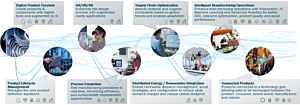Keeping Up with Sustainability in the Chemical Industry, Part 2
A User’s Guide to Not Killing the Planet
In Part 1 of Keeping Up with Sustainability in the Chemicals Industry, we discussed market trends and four key challenges the chemical industry faces when it comes to sustainability. Part 2 will focus on how organizations can uphold accountability for sustainability targets, realize business & environmental benefits through the digital thread and further considerations they must take into account.
Uphold Accountability: Understand, Track, and Measure
To forge a path toward accountability for sustainability targets, business leaders need to gain an understanding of the current state and then prioritize areas for improvement. For long-term viability, start by using available technologies to develop clarity and glean reliable metrics through a resource efficiency roadmap.
Then, as the enterprise gains maturity in metrics capture, insight gained through an energy management system (EMS) can optimize energy usage and reduce costs in industrial operations. Leveraging industrial internet of things (IIoT) platforms can provide visibility and enhancement to current distributed control systems (DCS). IIoT can make production operations safer and more efficient by extending technology that chemicals companies already have. Then, employing advanced analytics can enable visibility, monitoring, and analysis of energy consumption in real time.
Fortunately, the chemicals industry is well-positioned to improve operations through advanced analytics applications like artificial intelligence (AI) or machine learning (ML). This is due to advancements pioneered over more than 60 years of development of real-time connections to metering and instrumentation, historical data sources, and additional sources like financial data information. Underpinning an EMS is data collected by smart assets, so companies can apply a different lens to data already being collected.
The chemicals industry is well-positioned for advanced analytics applications like artificial intelligence or machine learning to improve their operations & sustainability with data already collected by smart assets.
Consider reaping the benefits of process Historians and ERP systems to reduce bottom-line costs by more effectively utilizing resources. An EMS can provide crucial visibility of energy sinks to proactively target areas of inefficiency and reduce demand costs. An EMS can also track metrics and manage budgeting to capture initial goals, feasibility, and progress.
Case Study: Energy Management
A network analysis for a $27B construction infrastructure manufacturer uncovered five previously undiscovered areas of optimization, with the goal of improving both financial and sustainability metrics. Once the business case was proven for optimizing the consumption of renewable fuels at a plant, the next stage was to deliver between a 5-10% improvement in quality while maximizing consumption of renewable fuel sources. Assessment and profiling first enabled energy monitoring, which in turn enabled energy optimization.
Realize Business & Environmental Benefits Through the Digital Thread
The digital thread is instrumental in achieving business goals by providing visibility into end-to-end processes. Companies can also apply the digital thread’s traceability- and transparency-enabling solutions to meet sustainability goals.
The digital thread can offer companies traceability- and transparency-enabling solutions to meet sustainability goals while improving the bottom line.
Pairing effective strategies with digital technologies can improve the bottom line while meeting sustainability goals through connected energy operations, smart facilities, and product innovation. On a broad scale, companies employing these strategies have seen a 5-30% improvement in energy efficiency and a 3-30% reduction in greenhouse gas (GHG) emissions.

For example, modeling and simulation can reduce:
- Waste & energy consumption and water usage by leveraging ML and AI to optimize processes
- Compliance risk by building regulatory and safety models
- Time and costs in other areas through efficiencies created by digital twins
A formulation and compliance workbench can model wastes and by-products, among other capabilities that facilitate effective compliance screening and integration with PLM and manufacturing solutions.
Case Study: Control Optimization/Model Predictive Control
A leading semiconductor manufacturing company implemented an AI/ML solution to optimize energy efficiency while taking various system impacts like equipment age and environment conditions into consideration. More than 2% greater energy efficiency was realized compared to earlier manual models, with annual energy efficiency improving by 10-19%. Additionally, the solution saved 180GWh of electricity consumption per year and reduced 95,000 tons of carbon emissions per year.
Case Study: Machine Vision
Leveraging AI/ML technologies to automate detection and notification processes for hazardous liquid spills helped a $20M midstream water management company to:
- Reduce its carbon footprint while increasing reliability
- Significantly increase recycling and reuse of its produced water.
With the potential to scale the technology across multiple facilities, this solution not only could detect and prevent environmental damage but was able to save the company thousands of dollars in potential government regulatory fines.
Modeling and simulation, control optimization, model predictive control, and machine vision are some capabilities that can offer operational and sustainability gains while assisting companies with compliance.
Further Considerations
The digital thread presents a vast array of opportunities to gain visibility into tracking and reaching sustainability goals, as seen in the graphic below that outlines key capabilities.
Still, companies shouldn't be afraid to start small. Implementing minor but validated solutions can cut down on costs while also furthering sustainability goals. A minimum viable product approach can provide value by solving one use case completely before extending to other areas of the business. Even small steps taken in response to an initial current-state assessment can have enduring effects, so lasting change is both possible and profitable.
Sustainability is also not a static state– companies will need the ability to make and sustain changes and improvements to the current paradigm as both the landscape and information continue to evolve. Solutions that offer visibility over a black-box approach, as well as the flexibility to alter inputs and outputs, are crucial to continued success in meeting sustainability targets.
To get the most out of digital thread capabilities, companies should start by understanding the current state.
This includes:
- Focusing on a minimum viable product approach
- Prioritizing solutions that offer visibility and flexibility over a black-box approach to respond to changing needs and an evolving landscape
Prioritize and Achieve a Sustainable Future
Assessing and tracking progress toward sustainability goals is the initial step for chemicals companies on the path to realizing compliance and business benefits as well as positive outcomes for the environment and society.
However, those goals can only be met by first understanding the current state; then, by leveraging the digital thread, sustainability goals are not only feasible but achievable.
Chemicals companies can realize sustainability progress by establishing a current state, pinpointing their most salient needs, and implementing targeted solutions that will help them reach their goals while keeping pace with Industry 5.0.



